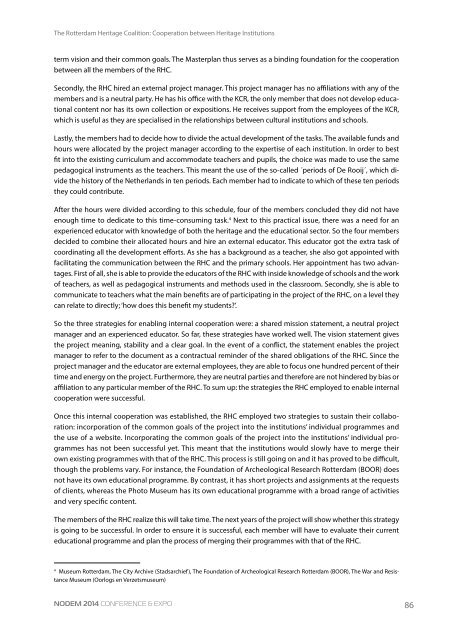NODEM 2014 Proceedings
NODEM 2014 Proceedings
NODEM 2014 Proceedings
Create successful ePaper yourself
Turn your PDF publications into a flip-book with our unique Google optimized e-Paper software.
The Rotterdam Heritage Coalition: Cooperation between Heritage Institutions<br />
term vision and their common goals. The Masterplan thus serves as a binding foundation for the cooperation<br />
between all the members of the RHC.<br />
Secondly, the RHC hired an external project manager. This project manager has no affiliations with any of the<br />
members and is a neutral party. He has his office with the KCR, the only member that does not develop educational<br />
content nor has its own collection or expositions. He receives support from the employees of the KCR,<br />
which is useful as they are specialised in the relationships between cultural institutions and schools.<br />
Lastly, the members had to decide how to divide the actual development of the tasks. The available funds and<br />
hours were allocated by the project manager according to the expertise of each institution. In order to best<br />
fit into the existing curriculum and accommodate teachers and pupils, the choice was made to use the same<br />
pedagogical instruments as the teachers. This meant the use of the so-called ´periods of De Rooij´, which divide<br />
the history of the Netherlands in ten periods. Each member had to indicate to which of these ten periods<br />
they could contribute.<br />
After the hours were divided according to this schedule, four of the members concluded they did not have<br />
enough time to dedicate to this time-consuming task. 4 Next to this practical issue, there was a need for an<br />
experienced educator with knowledge of both the heritage and the educational sector. So the four members<br />
decided to combine their allocated hours and hire an external educator. This educator got the extra task of<br />
coordinating all the development efforts. As she has a background as a teacher, she also got appointed with<br />
facilitating the communication between the RHC and the primary schools. Her appointment has two advantages.<br />
First of all, she is able to provide the educators of the RHC with inside knowledge of schools and the work<br />
of teachers, as well as pedagogical instruments and methods used in the classroom. Secondly, she is able to<br />
communicate to teachers what the main benefits are of participating in the project of the RHC, on a level they<br />
can relate to directly; ‘how does this benefit my students?’.<br />
So the three strategies for enabling internal cooperation were: a shared mission statement, a neutral project<br />
manager and an experienced educator. So far, these strategies have worked well. The vision statement gives<br />
the project meaning, stability and a clear goal. In the event of a conflict, the statement enables the project<br />
manager to refer to the document as a contractual reminder of the shared obligations of the RHC. Since the<br />
project manager and the educator are external employees, they are able to focus one hundred percent of their<br />
time and energy on the project. Furthermore, they are neutral parties and therefore are not hindered by bias or<br />
affiliation to any particular member of the RHC. To sum up: the strategies the RHC employed to enable internal<br />
cooperation were successful.<br />
Once this internal cooperation was established, the RHC employed two strategies to sustain their collaboration:<br />
incorporation of the common goals of the project into the institutions’ individual programmes and<br />
the use of a website. Incorporating the common goals of the project into the institutions’ individual programmes<br />
has not been successful yet. This meant that the institutions would slowly have to merge their<br />
own existing programmes with that of the RHC. This process is still going on and it has proved to be difficult,<br />
though the problems vary. For instance, the Foundation of Archeological Research Rotterdam (BOOR) does<br />
not have its own educational programme. By contrast, it has short projects and assignments at the requests<br />
of clients, whereas the Photo Museum has its own educational programme with a broad range of activities<br />
and very specific content.<br />
The members of the RHC realize this will take time. The next years of the project will show whether this strategy<br />
is going to be successful. In order to ensure it is successful, each member will have to evaluate their current<br />
educational programme and plan the process of merging their programmes with that of the RHC.<br />
4<br />
Museum Rotterdam, The City Archive (Stadsarchief), The Foundation of Archeological Research Rotterdam (BOOR), The War and Resistance<br />
Museum (Oorlogs en Verzetsmuseum)<br />
<strong>NODEM</strong> <strong>2014</strong> Conference & Expo<br />
86


